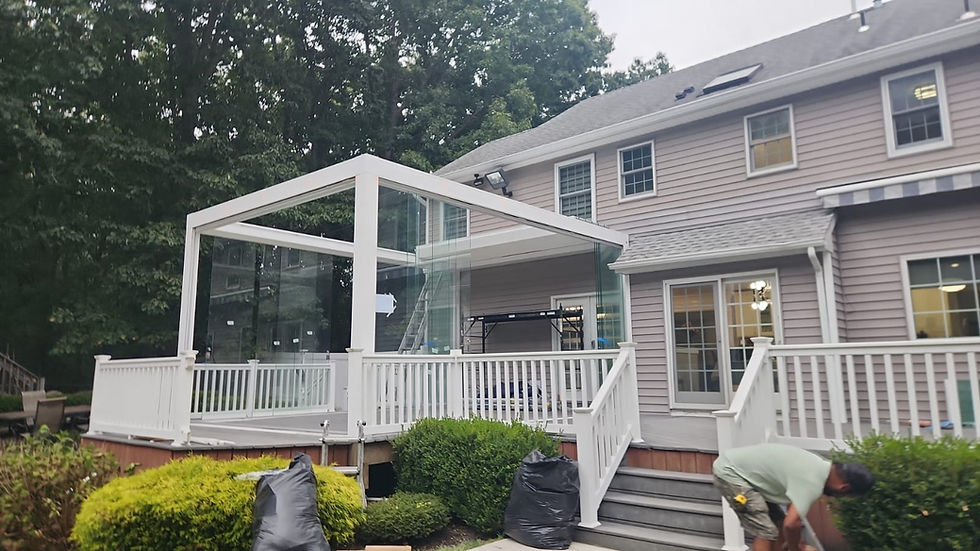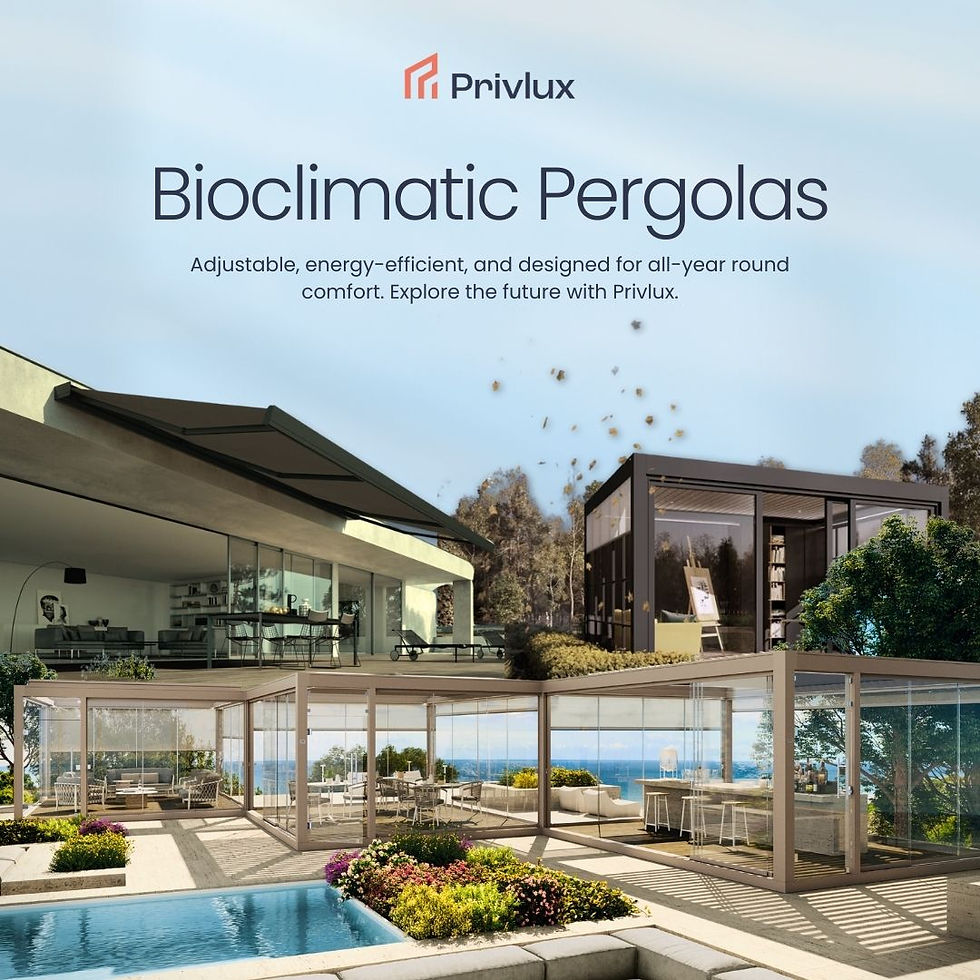Negotiating Urban Constraints: Privlux Outdoor Living Spaces that Maximize Small Footprints
- Privlux Inc.
- 41 minutes ago
- 4 min read
Urban Constraints in Outdoor Living
Urban living often comes with limitations. Tight lots, zoning restrictions, vertical density, and irregular property lines can make outdoor design feel like an afterthought. In cities such as New York, Manila, or Singapore, usable outdoor space may be reduced to a narrow backyard, a rooftop terrace, or a balcony.
Yet research shows that even modest outdoor access significantly enhances quality of life. A study in Landscape and Urban Planning (Van den Berg et al., 2015) found that private outdoor environments—no matter how small—contribute to stress recovery, mood regulation, and social well-being. The challenge, then, is not simply having outdoor space, but making it function well in restricted urban conditions.
This is where carefully engineered solutions—such as Privlux outdoor living spaces—prove their value. By leveraging compact structures, adjustable shading systems, and adaptable glass enclosures, even small footprints can be transformed into versatile, comfortable sanctuaries.

The Core Challenge: Making Small Work Big
Urban outdoor areas often share three constraints:
Limited Area – Most city plots leave little room for sprawling structures. Pergolas must fit into tight side yards, narrow courtyards, or rooftop perimeters.
Regulatory Restrictions – Height limits, setback rules, and load-bearing constraints on rooftops complicate construction.
Environmental Pressures – Sunlight reflection from adjacent buildings, urban heat island effects, and unpredictable wind patterns demand adaptive design.
Designing for these factors requires more than shrinking a suburban pergola; it requires rethinking scale, adaptability, and integration.

Compact Pergolas for Tight Lots
For narrow backyards or compact patios, scale and proportion matter. Oversized structures can overwhelm, but undersized ones may lack function.
Visualize Pergola (Basic and Plus): Compact motorized louver systems allow precise light and ventilation control without bulky framing. Their modular design makes them well-suited for narrow footprints while still offering weather adaptability.
Solidare Pergola: With its retractable fabric roof and slim framing, Solidare represents a practical solution for homeowners seeking shade and rain protection without the bulk. It is particularly effective in rowhouse settings or townhouse backyards where affordability and simplicity are key.
These solutions address the functional minimums—shade, rain protection, ventilation—while respecting scale.
Expanding Perception Through Max-Span Engineering
Small doesn’t always mean cramped. Advances in structural engineering allow pergolas to achieve wider spans with fewer posts, freeing up usable area beneath.
Uptrack Pergola: Engineered for maximum spans, Uptrack eliminates unnecessary vertical supports, creating a more open and uncluttered footprint. In rooftop or courtyard settings where every square meter counts, this openness makes a measurable difference in usability.
Architectural research supports the value of openness in small spaces: spatial perception studies confirm that reducing visual barriers enhances the feeling of expansiveness (Franz & Wiener, Journal of Environmental Psychology, 2008). In other words, fewer posts mean more psychological and functional space.
Flexible Shading for Changing Urban Conditions
Urban sites experience microclimates. Glass towers reflect solar heat into courtyards, wind tunnels form between buildings, and shade can disappear in the afternoon only to return suddenly. Pergolas that adapt dynamically to these shifting conditions outperform static shade structures.
LuxShade Pergola: Its retractable fabric roof spans wide areas seamlessly, ideal for rooftop decks or terraces where shading needs fluctuate. The ability to retract fully restores openness when desired.
Carrera Pergola: With integrated smart sensors, Carrera automatically adjusts louvers to respond to rain, wind, or sun. This is particularly valuable in dense urban contexts where residents may not always be home to adjust their outdoor systems manually.
These technologies ensure that outdoor living spaces remain usable despite unpredictable city weather and microclimate conditions.

Integrating Glass Enclosures in Small Sites
For urban homeowners, noise, pollution, and privacy are often as significant as weather. Here, glass enclosures extend beyond aesthetics; they create protective boundaries.
Skyview Pergola: Featuring glass roofing, it maximizes daylight in shaded courtyards while still offering protection. Pairing with sliding glass walls ensures year-round usability.
Visualize with Glass: By combining motorized louvers with operable glass panels, this model allows urban residents to fine-tune exposure—sliding panels open on cool days, sealing against noise or pollution when needed.
Research from Building and Environment (Frontczak & Wargocki, 2011) highlights that perceived comfort is influenced as much by control and adaptability as by actual temperature or noise levels. Glass, therefore, provides not just physical shelter but psychological security.
Practical Design Considerations for Urban Pergolas
When negotiating urban constraints, homeowners and architects should weigh:
Load Capacity: Rooftop installations must account for structural loads, especially with glass panels.
Privacy Screens: Urban density often requires lateral screening—integrated blinds, louvers, or frosted glass.
Maintenance Access: Compact sites demand designs that allow easy cleaning and upkeep without large clearance areas.
Regulatory Compliance: Height restrictions and building codes vary by city; pergola systems must be engineered accordingly.
Privlux outdoor living spaces are designed with modularity, adaptability, and compliance in mind—ensuring solutions can be tailored to the realities of urban sites.
Beyond Square Meters: The Value of Outdoor Space in Cities
Maximizing small outdoor spaces is not simply a design problem; it is a health and well-being opportunity. Studies show that access to outdoor environments—even balconies and terraces—improves physical activity levels and mental health in urban populations (Journal of Urban Health, Kweon et al., 2017).
A well-designed pergola turns these spaces into year-round extensions of the home, offering shade, shelter, and sanctuary. Whether compact like the Solidare, expansive like the Uptrack, versatile like the LuxShade, or protective like the Skyview, the choice of system should serve the homeowner’s lifestyle and environment.
Making the Most of Urban Footprints for Best Outdoor Living Spaces
Negotiating urban constraints requires creativity and precision. Small outdoor areas can become inviting retreats with the right pergola solution—whether that means a compact Visualize for narrow lots, a max-span Uptrack for rooftops, a retractable LuxShade for flexible shading, or a glass-enclosed Skyview for year-round comfort.
At Privlux Inc, we see outdoor living not as a luxury reserved for large properties, but as an essential quality-of-life feature—even in the smallest city spaces. For expert advice or a quotation on designing your own outdoor living space, call us on WhatsApp at 833 774 8589. Explore our pergola range—Visualize, Solidare, LuxShade, Uptrack, Skyview, and Carrera—to see how they can redefine your home’s outdoor comfort.
_edited.png)



Comments